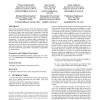Free Online Productivity Tools
i2Speak
i2Symbol
i2OCR
iTex2Img
iWeb2Print
iWeb2Shot
i2Type
iPdf2Split
iPdf2Merge
i2Bopomofo
i2Arabic
i2Style
i2Image
i2PDF
iLatex2Rtf
Sci2ools
KDD
2009
ACM
2009
ACM
On compressing social networks
Motivated by structural properties of the Web graph that support efficient data structures for in memory adjacency queries, we study the extent to which a large network can be compressed. Boldi and Vigna (WWW 2004), showed that Web graphs can be compressed down to three bits of storage per edge; we study the compressibility of social networks where again adjacency queries are a fundamental primitive. To this end, we propose simple combinatorial formulations that encapsulate efficient compressibility of graphs. We show that some of the problems are NP-hard yet admit effective heuristics, some of which can exploit properties of social networks such as link reciprocity. Our extensive experiments show that social networks and the Web graph exhibit vastly different compressibility characteristics. Categories and Subject Descriptors H.2.8 [Information Systems]: Database Applications--Data Mining; G.2.2 [Mathematics of Computing]: Graph Theory--Graph algorithms General Terms Algorithms, Expe...
| Added | 25 Nov 2009 |
| Updated | 25 Nov 2009 |
| Type | Conference |
| Year | 2009 |
| Where | KDD |
| Authors | Flavio Chierichetti, Ravi Kumar, Silvio Lattanzi, Michael Mitzenmacher, Alessandro Panconesi, Prabhakar Raghavan |
Comments (0)

